The Intel SSD DC S3500 is designed for data center applications such as in cloud computing, web hosting and other read-intensive environments, and the drive features an in-house controller, 20nm MLC NAND, and form factors at both 2.5" and 1.8". The DC S3500 is the latest SSD in Intel’s new line while its sibling, the DC S3700 that we’ve also reviewed, is designed for the mainstream and high-performance enterprise market segments. These SATA 6Gb/s interfacing drives both take on the new four-digit naming convention Intel is incorporating to give more clarity and distinction to which drives belong to which category (consumer, pro, enterprise).
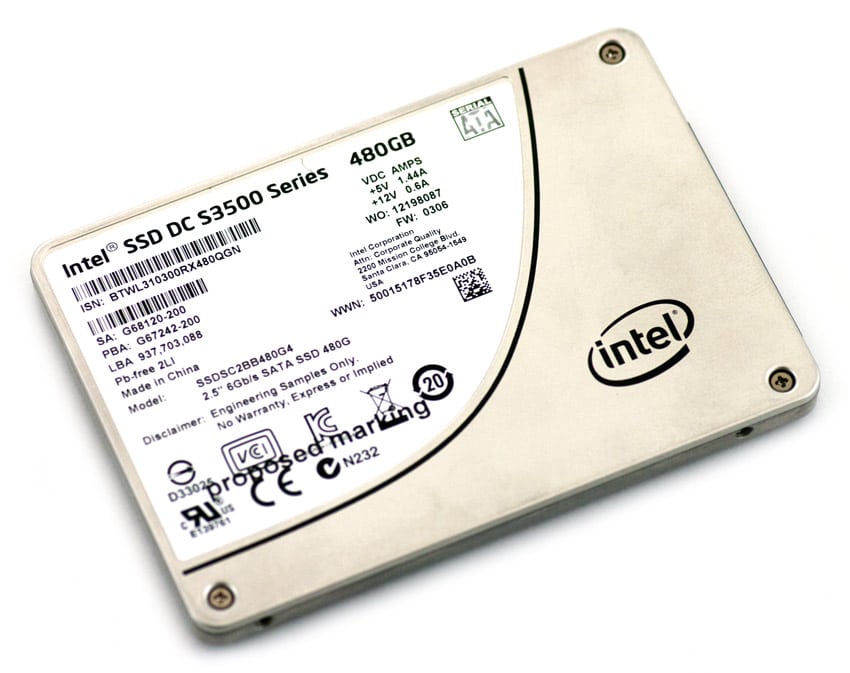
Organizations and consumers alike have come to expect a high level of quality, reliability and support from Intel, which helps to delineate the boundary between Intel drives and others in the space. During our recent visit to Intel’s Folsom, CA labs, we were able to experience the quality testing up close and were impressed with what we saw. Intel also distances itself from the competition when it comes to components – a key area that enables Intel to deliver upper-echelon quality. Intel’s SSDs utilize Intel’s own proprietary NAND and controller technology as well as in-house engineered software. Intel’s model gives them particularly strong insight into support for drives on top of the ability to better drive performance. Hardware-wise, the S3500 utilizes 20nm MLC versus 25nm eMLC on the S3700, though Intel is integrating the same controller that provided robust performance with the S3700 – we expect similar results.
On that note, within its class, the S3500 offers solid performance figures with 4k random specs quoted at up to 75,000 IOPS read and 15,500 IOPS write. The spec for the S3500’s latency is also strong, coming in just behind the S3700 at 50 μs for read activity and 65 μs for write activity (S3700, 45μs/65μs), though with the exact same highly predictable response times with latencies of <500μs for 99.9% of the time.
The DC S3500 is also designed to meet a variety of space-constrained applications, shipping in both 1.8" and 2.5" form factors. The standard 2.5" drive is available in 80GB, 120GB, 160GB, 240GB, 300GB, 480GB, 600GB and 800GB capacities. The 1.8" form factor is available in 80GB, 240GB, 400GB and 800GB capacity points. Each drive supports full data path protection, AES 256-bit encryption, power loss protection for in-flight data, and very low power consumption. Intel rates power consumption at just 650mW at idle, 1.3W during read activity and 5W during writes (typical).
The Intel SSD DC S3500 is available through Intel distributors and resellers with a five year warranty. Suggested channel pricing begins at $115 for the 1.8" 80GB model and ranges up to $979 for the 2.5" 800GB drive.
Intel SSD DC S3500 Series Specifications
- Capacities
- 2.5”
- 120GB
- Sequential Read: up to 445 MB/s
- Sequential Write: up to 135 MB/s
- Random 4K Read/Write: 75,000 IOPS / 4,600 IOPS
- 240GB
- Sequential Read: up to 500 MB/s
- Sequential Write: up to 260 MB/s
- Random 4K Read/Write: 75,000 IOPS / 7,500 IOPS
- 480GB
- Sequential Read: up to 500 MB/s
- Sequential Write: up to 410 MB/s
- Random 4K Read/Write: 75,000 IOPS / 11,000 IOPS
- 800GB
- Sequential Read: up to 500 MB/s
- Sequential Write: up to 450 MB/s
- Random 4K Read/Write: 75,000 IOPS / 11,500 IOPS
- 120GB
- 1.8”
- 240GB
- Sequential Read: up to 500 MB/s
- Sequential Write: up to 260 MB/s
- Random 4K Read/Write: 75,000 IOPS / 7,500 IOPS
- 400GB
- Sequential Read: up to 500 MB/s
- Sequential Write: up to 380 MB/s
- Random 4K Read/Write: 75,000 IOPS / 11,000 IOPS
- 800GB
- Sequential Read: up to 500 MB/s
- Sequential Write: up to 450 MB/s
- Random 4K Read/Write: 75,000 IOPS / 15,500 IOPS
- 240GB
- Read / Write Latency: 50 μs / 65 μs
- Interface SATA 6Gb/s, compatible with SATA 3Gb/s and 1.5Gb/s
- Form Factor: 2.5" and 1.8"
- Intel 20nm MLC NAND
- AES 256-bit Encryption
- Endurance
- Lifetime Rating: 80 GB: 45 TBW; 120 GB: 70 TBW; 160 GB: 100 TBW; 240 GB: 140 TBW; 300 GB: 170 TBW; 400 GB: 225 TBW; 480 GB: 275 TBW; 600 GB: 330 TBW; 800 GB: 450 TBW
- MTBF: 2 Million Hours
- Power Consumption
- Active: up to 5 W Typical
- Idle: 650 mW Typical
- Environmental
- Operating Temperature: 0° C to 70° C
- Nonoperating Temperature: -55° C to 95° C
- Shock (operating and non-operating): 1,000 G/0.5 msec
- Height: 2.5” 7.0 mm thick; 1.8” 5 mm thick
- Weight: 2.5” 80-240GB: 70g ± 2g; 2.5” 300-800GB: 72g ± 2g; 1.8” 80GB: 35g ± 2g; 1.8” 240-800GB: 37g ± 2g
- 2.5”
Video Overview
Design and Build
The Intel SSD DC S3500 very closely resembles its sibling, the DC S3700 in appearance and form factor. The S3500 features a 7mm slim design for the 2.5" model and a 5mm ultra-thin design for the 1.8" form factor. The slim form factors make the S3500 a simple fit in just about any form factor from blade servers to flash arrays.
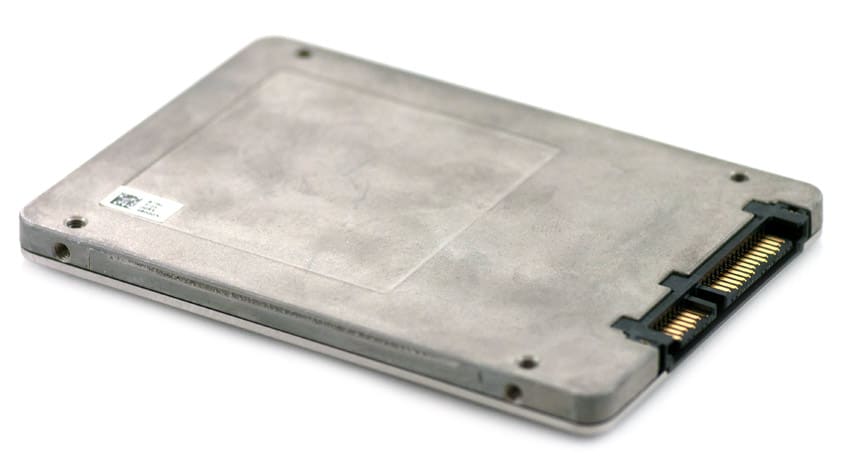
Starting externally, the entire outer shell of the SSD DC S3500 is unfinished metal alloy which yields an industrial style to the SSD. The top cover houses a product information label which provides relevant specs including capacity, model and form factor. The sides of the SSD feature four screw holes that enable the drive to be mounted easily.
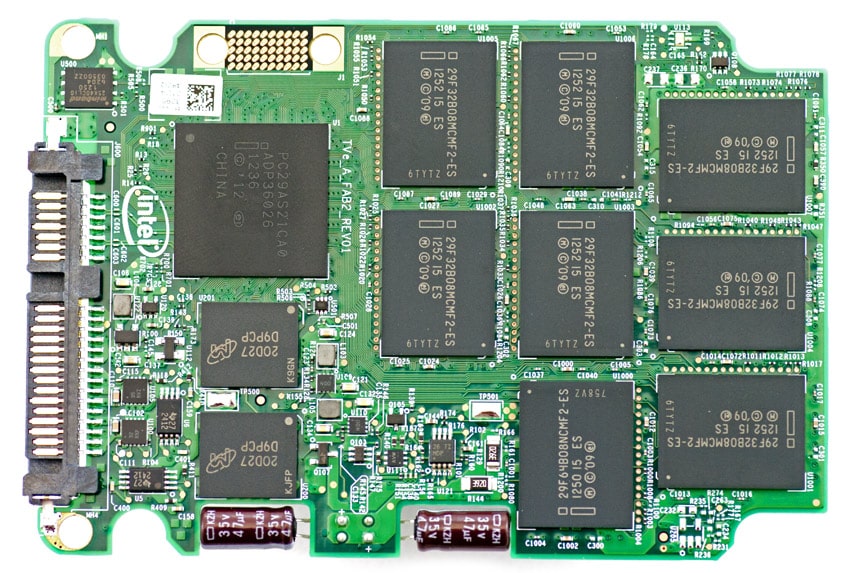
The top cover can be removed by taking out four screws, one hidden by the product information label. With the cover off, there is a single circuit board fitted to the metal case with some plastic shims.
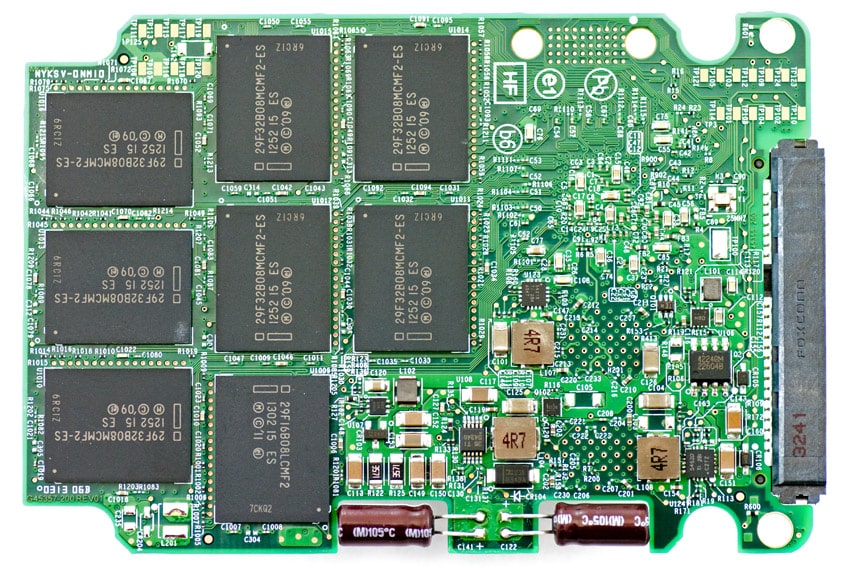
Just like the Intel SSD DC S3700, the S3500 features an Intel PC29AS21CA0 controller. Intel also incorporates their own MLC NAND with the S3500. Our 480GB test model includes 14x32GB NAND packages as well 1x64GB NAND package and 1×16 NAND package for a total of 528GB which is over-provisioned at 10%. This unique NAND configuration isn’t only found in the S3500; the S3700 also featured a less typical arrangement as did the Hitachi SSD400M and SSD400S.B.
Intel has also soldered power-fail capacitors on one edge of the board to protect in-flight data in the event of a power failure.
Testing Background and Comparables
The Intel SSD DC S3500 uses an Intel PC29AS21CA0 controller and 20nm MLC NAND with a SATA 6 Gb/s interface.
Comparables for this review:
- Micron M500 480GB (480GB, Marvell 9187 controller, Micron 20nm MLC NAND Flash, 6.0Gb/s SATA)
- Micron M500 960GB (960GB, Marvell 9187 controller, Micron 20nm MLC NAND Flash, 6.0Gb/s SATA)
- Samsung SSD 840 Pro (512GB, 300mhz Samsung 3-core MCX controller, Samsung 2Xnm Toggle NAND Flash, 6.0Gb/s SATA)
- Samsung SM843 (240GB, 300mhz Samsung 3-core MCX controller, Samsung 2Xnm Toggle NAND Flash, 6.0Gb/s SATA)
- Intel SSD 520 (240GB, SandForce SF-2500 controller, Intel 25nm MLC NAND Flash, 6.0Gb/s SATA)
- Smart CloudSpeed (240GB, SandForce SF-2581 controller, Smart 24nm MLC NAND, 6.0Gb/s SATA)
- Seagate 600 Pro (200GB, LAMD LM87800 controller, Toshiba 19nm MLC NAND, 6.0Gb/s SATA)
All SAS/SATA enterprise SSDs are benchmarked on our second-generation enterprise testing platform based on a Lenovo ThinkServer RD630. This new Linux-based testing platform includes the latest interconnect hardware such as the LSI 9207-8i HBA as well as I/O scheduling optimizations geared towards best-case flash performance. For synthetic benchmarks, we utilize FIO version 2.0.10 for Linux and version 2.0.12.2 for Windows.
- 2 x Intel Xeon E5-2620 (2.0GHz, 15MB Cache, 6-cores)
- Intel C602 Chipset
- Memory – 16GB (2 x 8GB) 1333Mhz DDR3 Registered RDIMMs
- Windows Server 2008 R2 SP1 64-bit, Windows Server 2012 Standard, CentOS 6.3 64-Bit
- 100GB Micron RealSSD P400e Boot SSD
- LSI 9211-4i SAS/SATA 6.0Gb/s HBA (For boot SSDs)
- LSI 9207-8i SAS/SATA 6.0Gb/s HBA (For benchmarking SSDs or HDDs)
- Mellanox ConnectX-3 10GbE PCIe 3.0 Adapter
- Mellanox ConnectX-3 InfiniBand PCIe 3.0 Adapter
Application Performance Analysis
In the enterprise market there is a huge difference between how products claim to perform on paper and how they perform in a production environment. We understand the importance of evaluating storage as a component of larger systems, most importantly how responsive storage is when interacting with key enterprise applications. To this end, we’ve rolled out our first application tests including our proprietary MarkLogic NoSQL Database Storage Benchmark and MySQL performance via SysBench.
In our MarkLogic NoSQL Database environment, we test groups of four SATA or SAS SSDs with a usable capacity greater than or equal to 200GB. Our NoSQL database requires roughly 650GB of free space to work with, evenly divided between four database nodes. In our testing environment, we use an SCST host and present each individual SSD in JBOD, with one allocated per database node. The test repeats itself over 24 intervals, requiring between 30-36 hours total for the SSDs in this category. Measuring the internal latencies seen by the MarkLogic software, we record both total average latency, as well as interval latency for each SSD.
In our overall average latency ranking of our MarkLogic NoSQL database benchmark, the Intel SSD DC S3500 came out on top with the lowest overall latency. What’s most surprising is how much faster the S3500 is compared to the other light-enterprise SSDs.
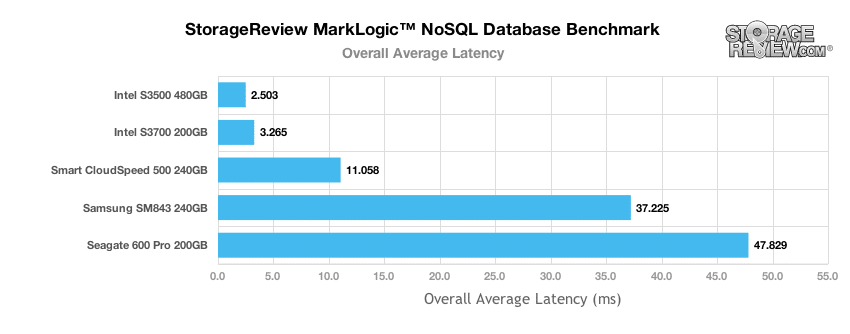
Drilling into the average latency measured throughout the entire testing period, the Intel S3500 shines in our NoSQL environment, with latency spikes staying between 6-19ms over the entire test.
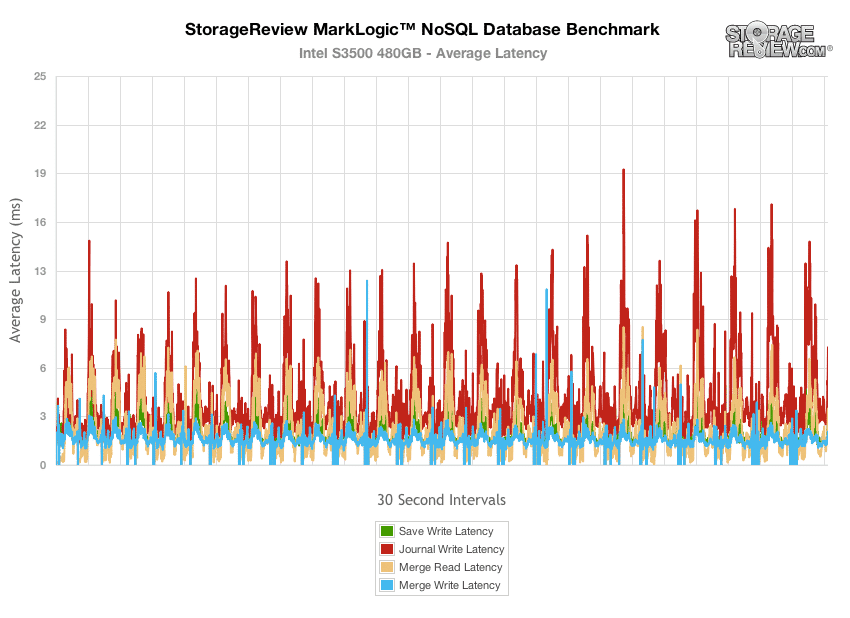
The Intel S3700 came in second to the S3500, even with its higher-performance (but lesser capacity) NAND configuration. It had latency that crept up slightly compared to the S3500, with spikes measuring between 10-32ms. Overall it still performed quite well in our NoSQL test.
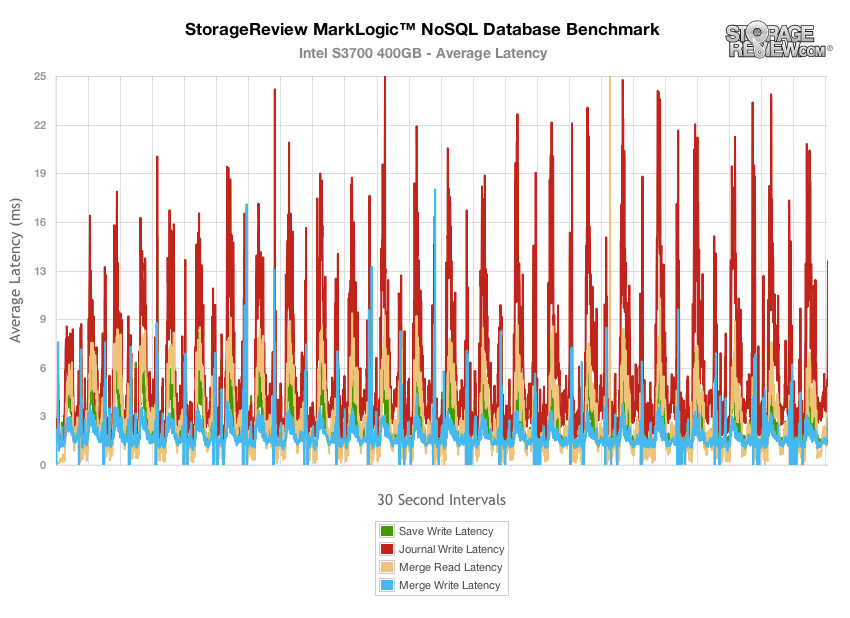
Moving to the next SSD in the light-enterprise category that we included in our MarkLogic tests, latency started to pick up significantly. We recorded peaks as high as 1,907ms, with many peaks measuring between 60-100ms.
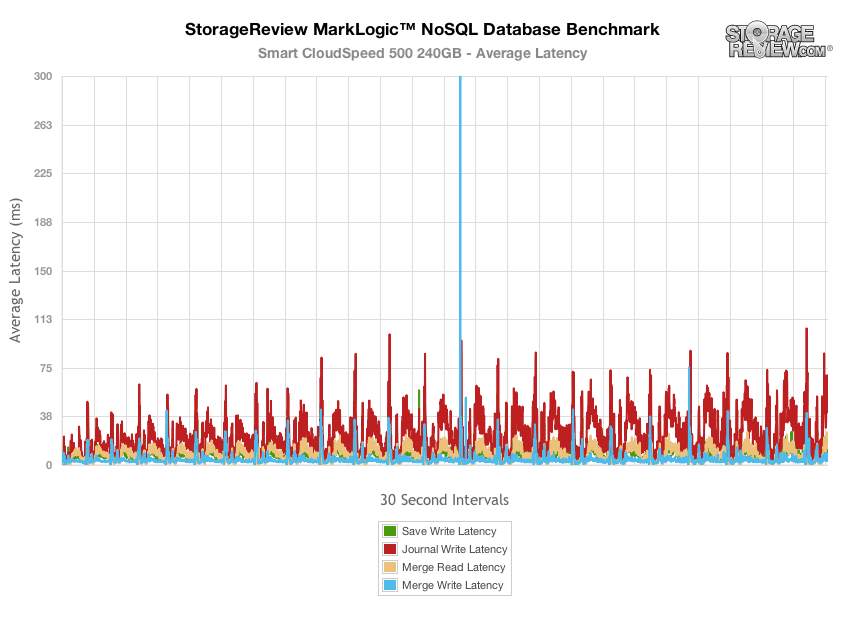
Next in line was the Samsung SM843, which further pushed up the latency ceiling with spikes measuring between 150-500ms in steady-state and one spike topping 1,562ms.
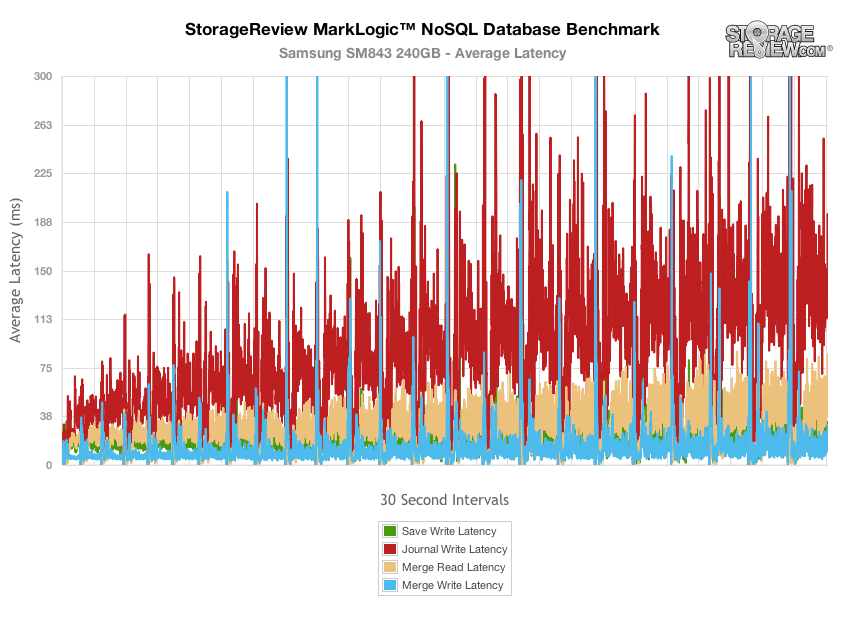
The Seagate 600 Pro came in towards the bottom in our MarkLogic NoSQL testing, with latency picking up significantly as the drive neared steady-state performance. With this SSD, latency peaks measured between 150-400ms, with the largest spike of 490ms.
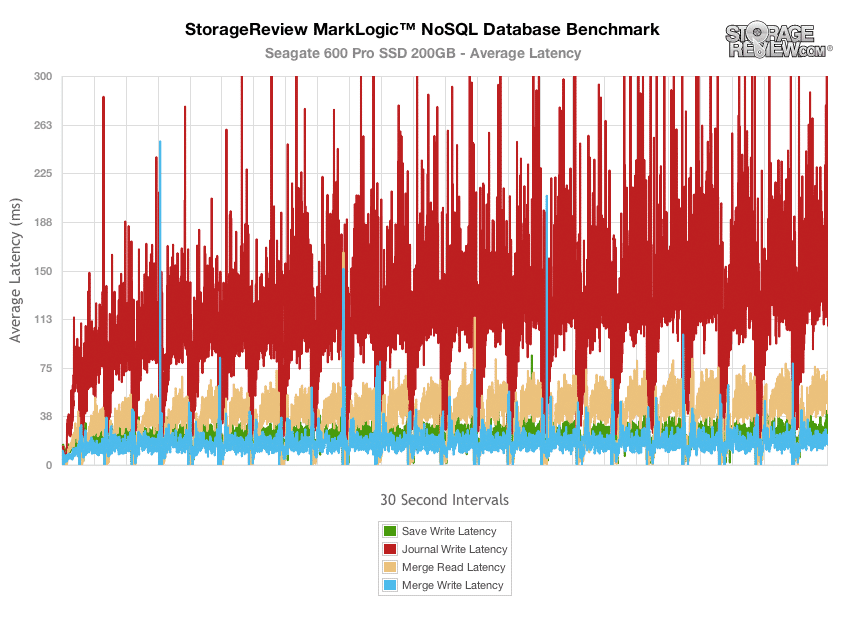
Our next application test consists of Percona MySQL database test via SysBench which measures the performance of OLTP activity. In this testing configuration, we use a group of Lenovo ThinkServer RD630s and load a database environment onto a single SATA, SAS or PCIe drive. This test measures average TPS (Transactions Per Second), average latency, as well as average 99th percentile latency over a range of 2 to 32 threads.
Comparing average TPS in our group, the Intel SSD DC S3500 came in second place behind its more performance-oriented sibling S3700 and just ahead of the Seagate 600 Pro SSD. The Intel SSD DC S3500’s performance ranged from 209TPS at 2 threads up to 1242TPS at 32 threads.
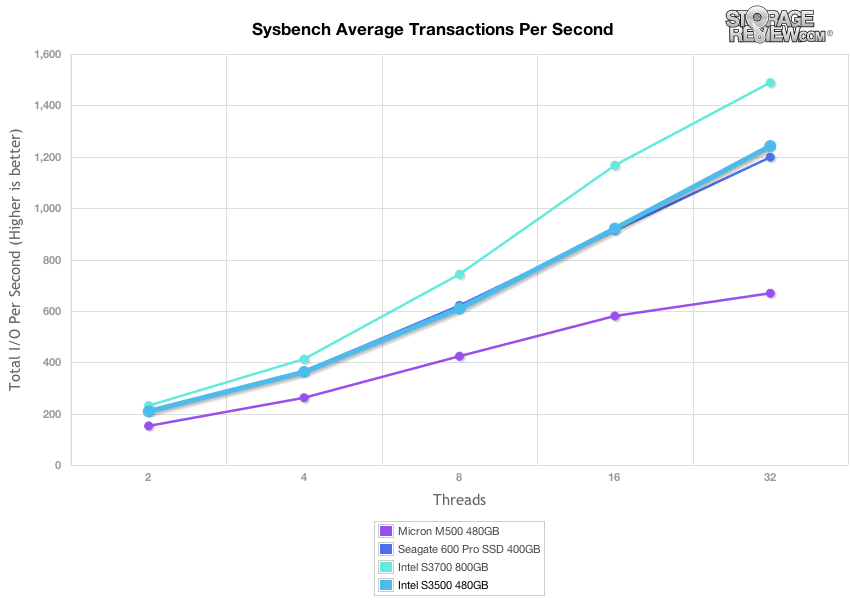
Comparing average latency over the course of 1 hour test segments, we measured average latency of the Intel SSD DC S3500 ranging from 9.58ms at 2 threads up to 25.77ms at 32 threads. Again, only the Intel SSD DC S3700 performed better.
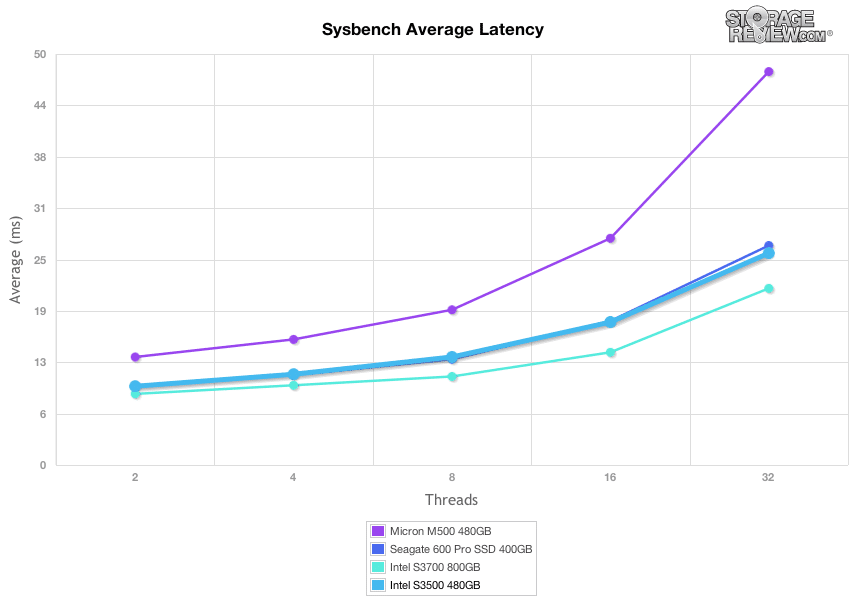
Examining the lowest overall 99th percentile latency, the Intel SSD DC S3500 provided response times that couldn’t quite match its sibling S3700, but stayed in line with the other SSDs, measuring 30 to 54ms over the range of thread-counts.
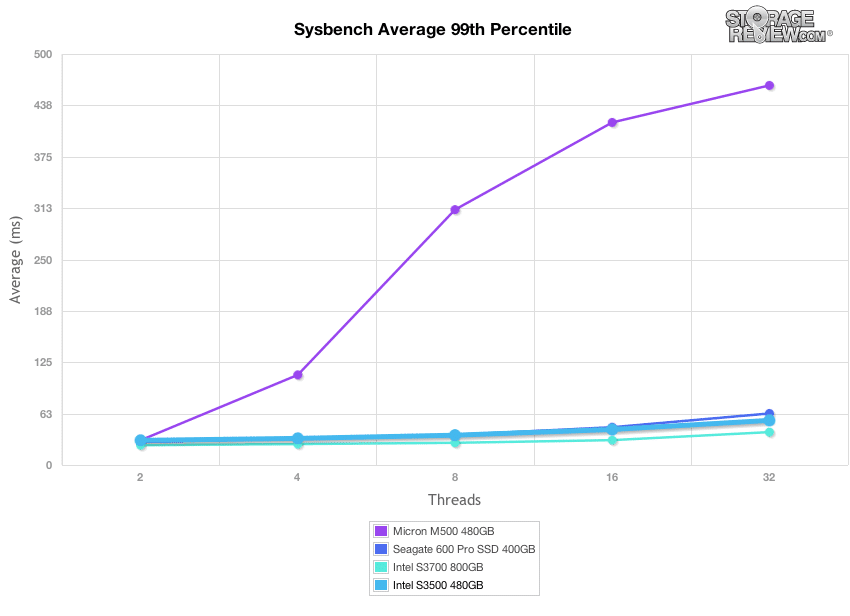
Enterprise Synthetic Workload Analysis
Flash performance varies throughout the preconditioning phase of each storage device. Our synthetic enterprise storage benchmark process begins with an analysis of the way the drive performs during a thorough preconditioning phase. Each of the comparable drives are secure erased using the vendor’s tools, preconditioned into steady-state with the same workload the device will be tested with under a heavy load of 16 threads with an outstanding queue of 16 per thread, and then tested in set intervals in multiple thread/queue depth profiles to show performance under light and heavy usage.
Preconditioning and Primary Steady-State Tests:
- Throughput (Read+Write IOPS Aggregate)
- Average Latency (Read+Write Latency Averaged Together)
- Max Latency (Peak Read or Write Latency)
- Latency Standard Deviation (Read+Write Standard Deviation Averaged Together)
Our Enterprise Synthetic Workload Analysis includes two profiles based on real-world tasks. These profiles have been developed to make it easier to compare to our past benchmarks as well as widely-published values such as max 4k read and write speed and 8k 70/30, which is commonly used for enterprise drives.
- 4k
- 100% Read or 100% Write
- 100% 4k
- 8k 70/30
- 70% Read, 30% Write
- 100% 8k
Our first test measures 100% 4k random write performance with a load of 16T/16Q. In this setting, the bursting nature of the Intel SSD DC S3500 tested at 56,300 IOPS, which then leveled off around 13,000 IOPS as the drive neared steady-state. The initial burst was near the middle of the group, though the S3500 sustained its burst longer than several drives. However, the Seagate 600 Pro SSD won with high IOPS sustained throughout the testing.
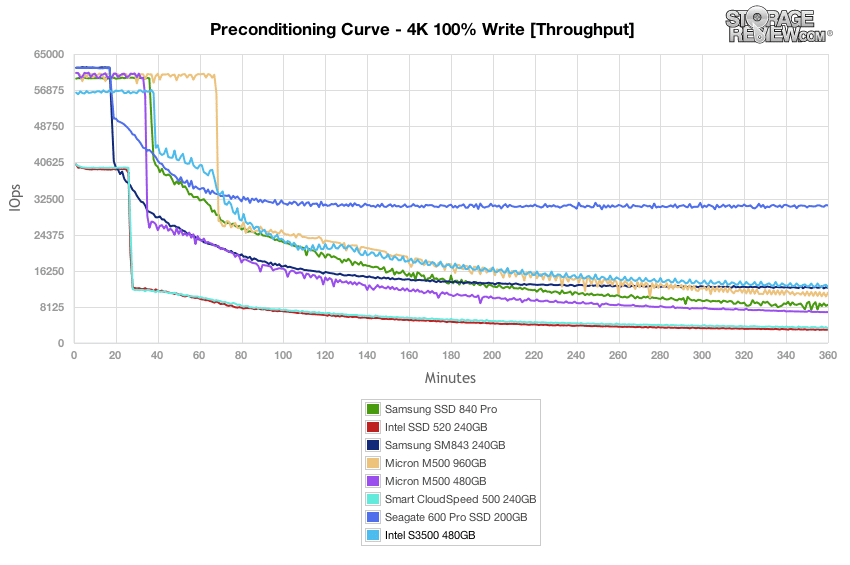
With a heavy 16T/16Q load, the Intel SSD DC S3500 measured 4.54ms in burst and scaled up to 20.33ms as it neared steady-state. The burst figure was quite low while the steady-state figures were second only to the Seagate 600 Pro.
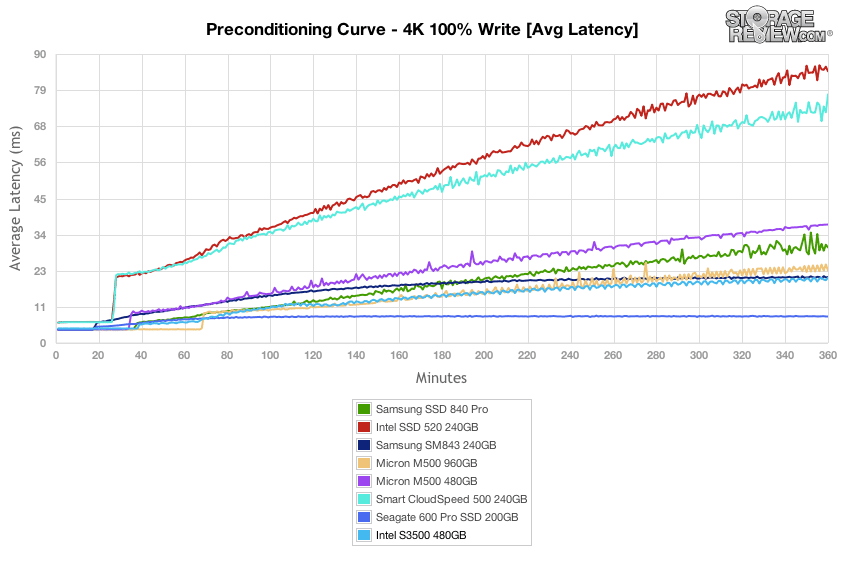
Comparing max latency between the SSDs, the Intel SSD DC S3500 had max response times ranging 80-100ms in steady-state – a figure that was far superior to the other drives in the group with the next best drive being the Intel SSD 520 at around 180-240ms in steady-state.
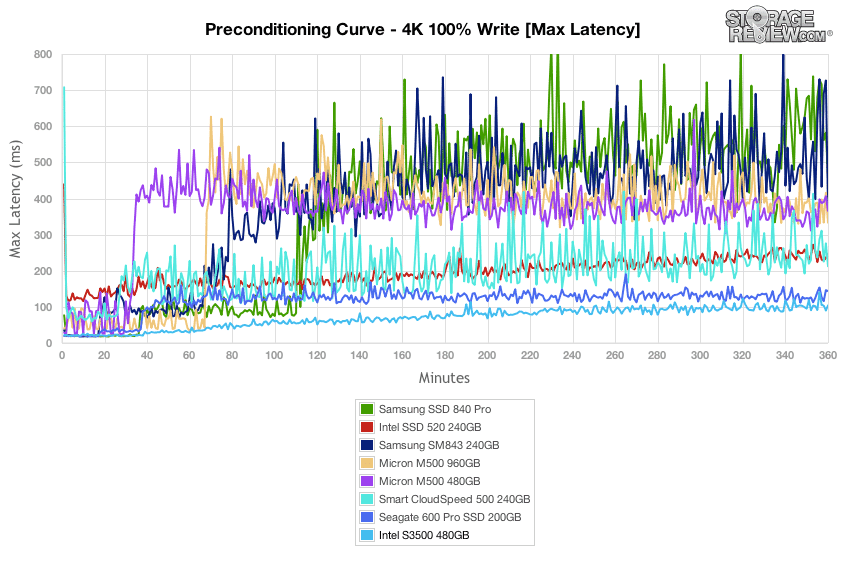
Looking even closer at the latency consistency in our 4k random write workload, the Intel SSD DC S3500 out-performed the other SSDs for the first half of the test, though the Seagate 600 Pro SSD caught up and overtook the S3500.
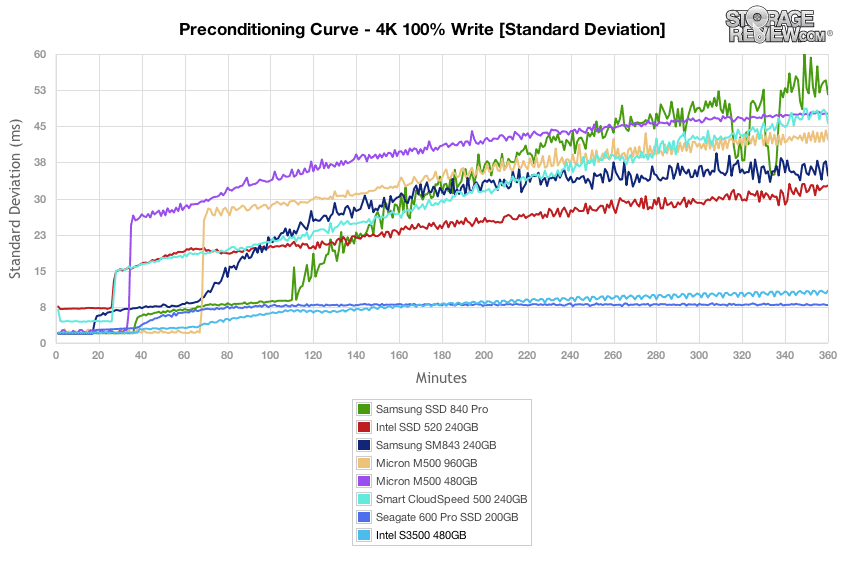
After 6 hours of preconditioning, the Intel SSD DC S3500 offered 4k random read performance at 65,500 IOPS and write speed at 12,500 IOPS. The write figures are class-leading along with those from the Seagate 600 Pro and the Samsung SM843 and 840 Pro, but the read performance was well below the 600 Pro’s.
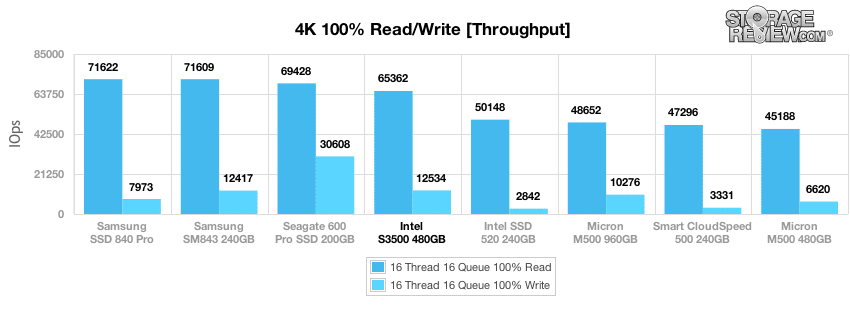
With a workload of 16T/16Q, the Intel SSD DC S3500 offered an average 4k random read latency of 3.914ms, with a write latency of 20.42ms.
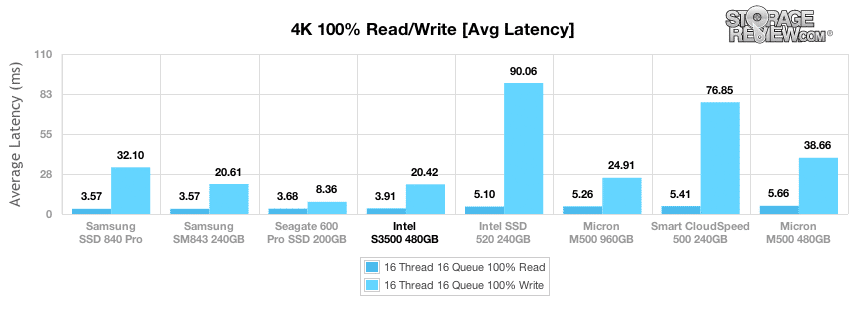
Max latency from the Intel SSD DC S3500 measured a peak read response time of 22.934ms and a peak write latency of 128ms.
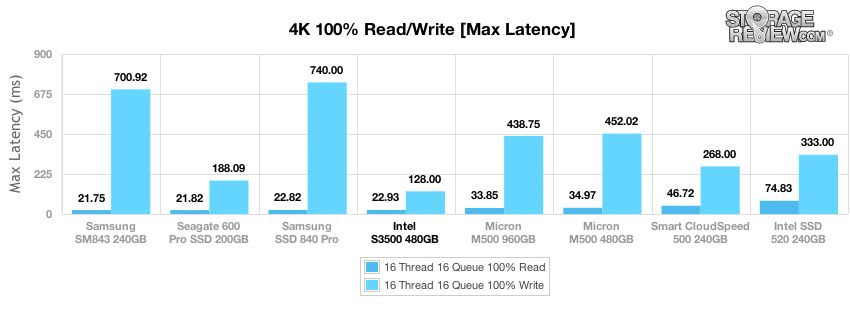
Comparing latency consistency, the Intel SSD DC S3500 had marks near the top of the group, though it was again edged out by the Seagate 600 Pro.
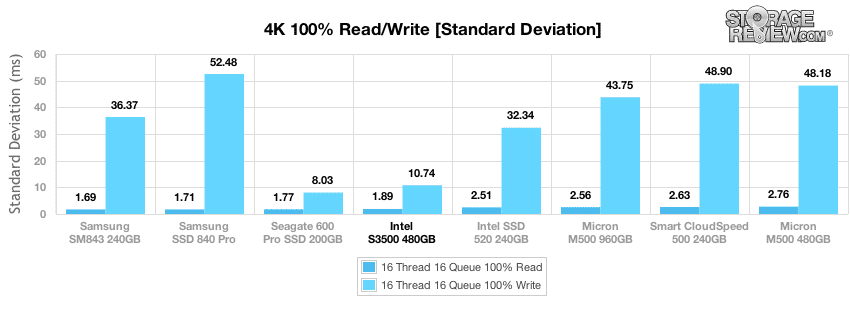
In our next workload, we look at an 8k profile with a 70/30 read/write mixed ratio. In this setting, the Intel SSD DC S3500 started off around 45,000 IOPS burst which slowed to a speed around 21,000 IOPS near steady-state. The burst and steady-state performance out-ranked the competition except at the very end of the test where the Seagate 600 Pro caught up.
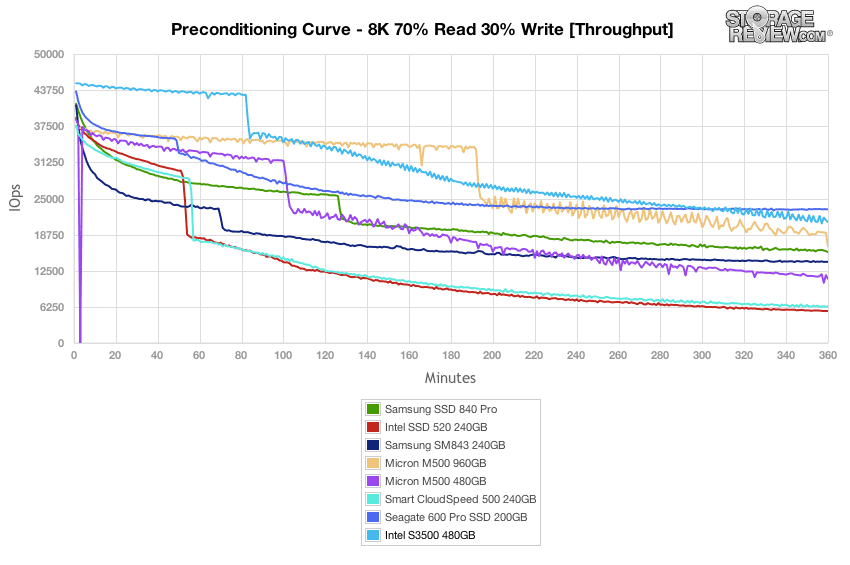
Average latency of the Intel SSD DC S3500 measured 5.69ms at the beginning of our 8K 70/30 preconditioning test, which increased to around 12ms as it neared steady-state.
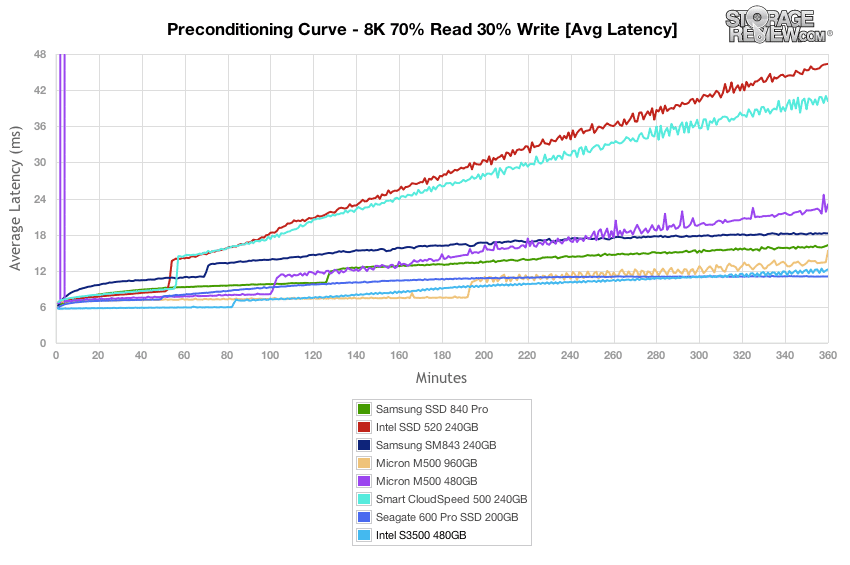
Over the duration of our 8K 70/30 test, the Seagate 600 Pro and Intel SSD DC S3500 offered the best peak response times, with latency max measuring below 70ms for the duration of the test from the S3500.
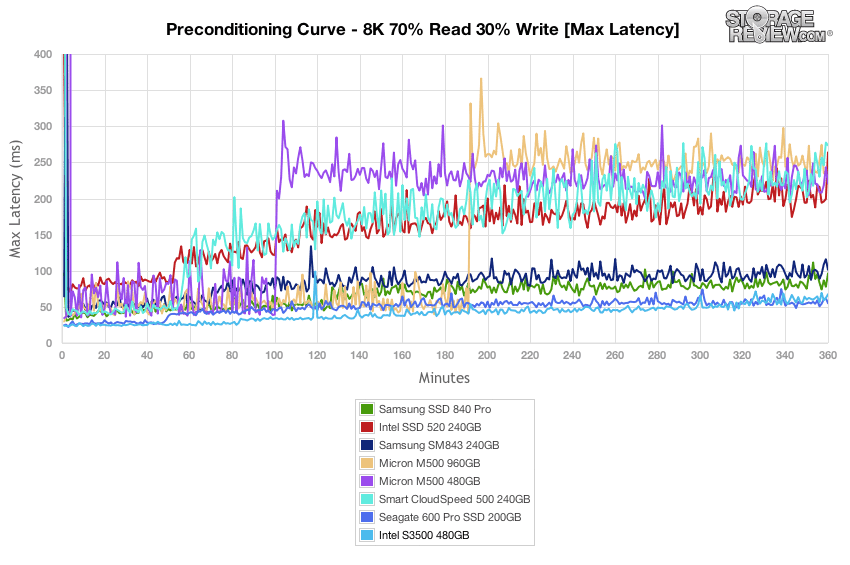
Latency consistency of the Intel SSD DC S3500 maintained the best marks until the end of the test where the Seagate 600 Pro overtook first place. At times, the S3500 had also been challenged earlier on by the Crucial M500 960GB.
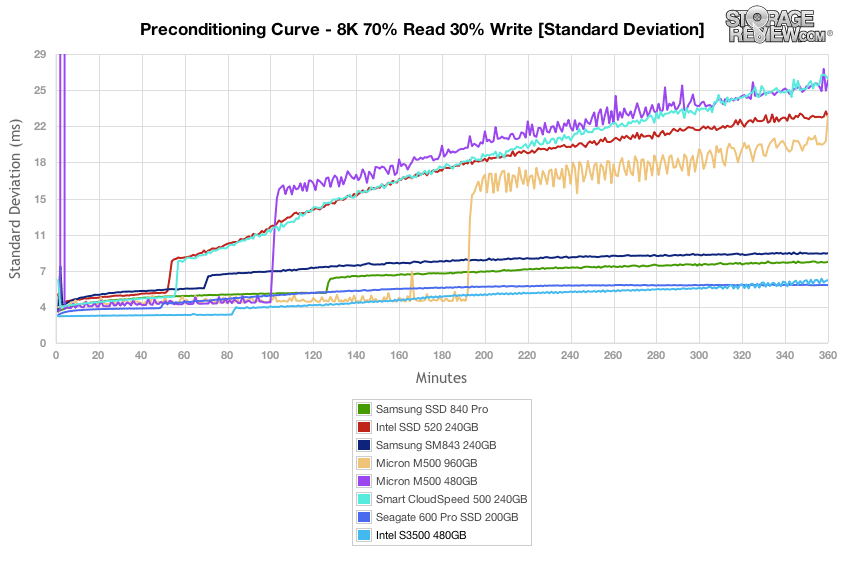
Compared to the fixed 16 thread, 16 queue max workload we performed in the 100% 4k write test, our mixed workload profiles scale the performance across a wide range of thread/queue combinations. In these tests, we span workload intensity from 2 threads and 2 queue up to 16 threads and 16 queue. In the expanded 8k 70/30 test, the Intel SSD DC S3500 peaked at 20,776 IOPS with a workload of 16T/16Q, which was again bested only by the Seagate 600 Pro.
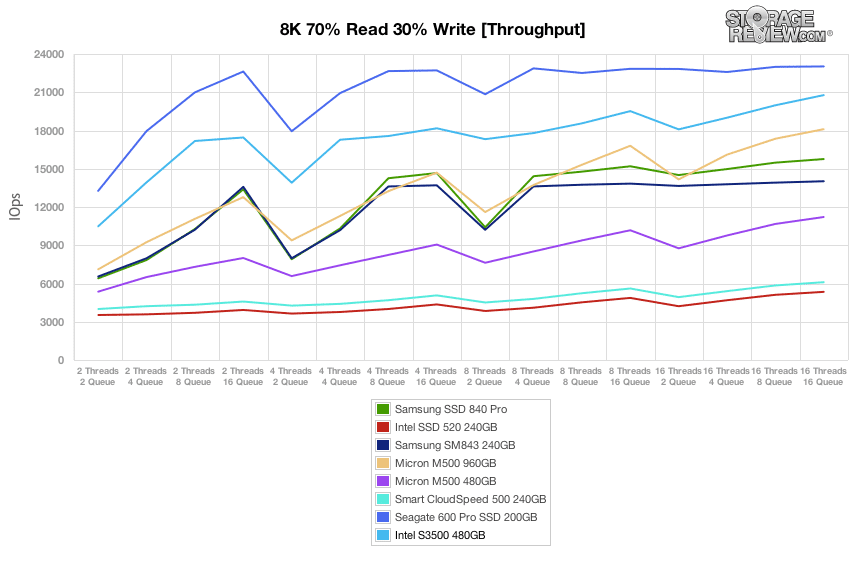
Average latency for the Intel SSD DC S3500 and the Seagate 600 Pro was superior for the entirety of the test.
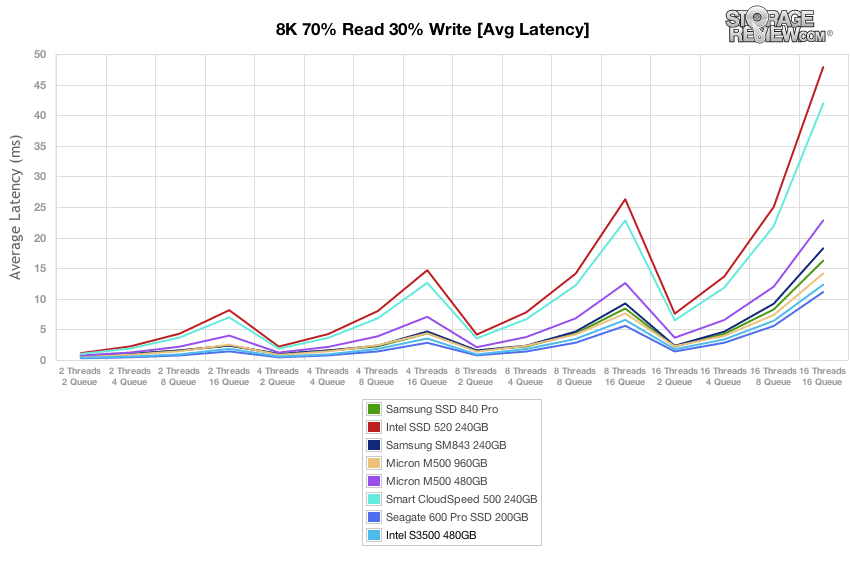
Over the duration of our varying load 8k 70/30 test, max latency stayed very low from the Intel SSD DC S3500, with the peak staying under 25ms for the bulk of the test before edging up to around 75ms with the highest 16T/16Q load.
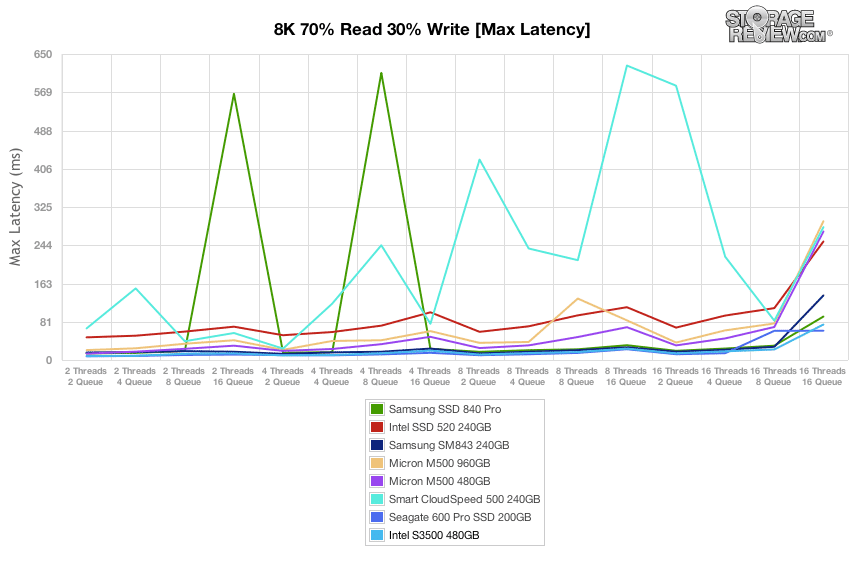
Standard deviation from the Intel SSD DC S3500 in our test environment was quite good achieving the second lowest peak of any of the SSDs.
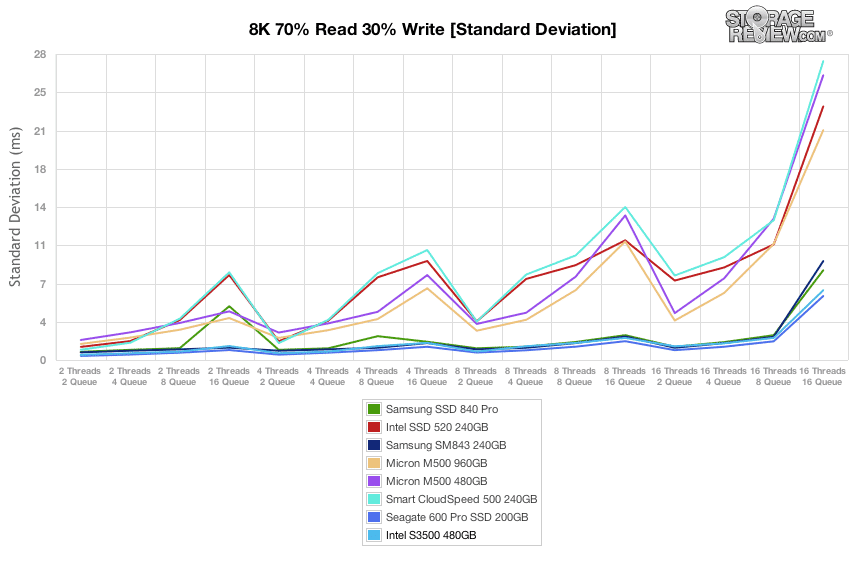
Conclusion
The Intel SSD DC S3500 is an enterprise-class SSD designed to take on read-intense workload applications such as cloud computing or web hosting. The drive interfaces over SATA 6Gb/s and utilizes Intel 20nm MLC NAND, and it ships in both 2.5" slim and 1.8" ultra-thin form factors at 7mm and 5mm z-heights, respectively. Beyond that, the S3500 features an in-house designed controller – the same controller that drove the S3700 to deliver exceptional performance. The S3500 also comes in a massive range of capacities that start as low as 80GB and range all the way up to 800GB. The 2.5" form factor offers 8 capacities, while the 1.8" form factor offers 4 capacities.
Overall, the SSD DC S3500 from Intel proved to be an extremely tough competitor. Routinely, it beat out all of the competition soundly, except for the Seagate 600 Pro. The LAMD-based Seagate drive challenged and often overtook the top position from the S3500 in synthetic benchmarks. The S3500’s 8k throughput was around 5,000 IOPS greater than most of the SSDs except the 600 Pro, and in 4k testing the results were similar. Consistently, across 4k and 8k testing workloads the S3500 also delivered some of the lowest response times with very low peaks in max latency and solid postings in standard deviation. Where the Intel S3500 really shined though was in our application workloads, including our proprietary MarkLogic NoSQL test. It handily beat out the Seagate 600 Pro by a huge margin, keeping latency figures grouped closer together over the duration of the test. When it came to SysBench, the S3500 was the top-performer in the light-enterprise group, though it lagged slightly behind the S3700. The SysBench testing, which measures OLTP, saw the S3700 at the front of the group, though this was expected as the S3700 is weighted more toward performance.
Similar to what we noted in our S3700 review, Intel made some impressive claims of 0.05ms peak response times with a 1T/1Q 4K random read or write load with the S3500. That isn’t fully representative of all enterprise conditions though. In our synthetic benchmarks with a heavier load of 16T/16Q, well past the point of full saturation, we measured peak response times of 80-100ms throughout our preconditioning process. In our application tests we did note exceptionally strong performance from the S3500, including class-leading performance in our MarkLogic NoSQL test. In that workload, latency spiked only as high as 21ms. In our SysBench OLTP test as well, 99th percentile latency measured between 30-54ms between 2 to 32 threads. For most buyers, the claimed latency figures are good starting points, but it really comes down to how the SSD performs in the workloads its destined to drive.
Pros
- Latency figures in our 4k and 8k workloads were generally near the top
- Top performance of tested SSDs including S3700 for our real-world Mark Logic testing
- Very consistent latency in application workloads
Cons
- S3500 not offered in higher over-provisioned models
Bottom Line
The Intel SSD DC S3500 provides organizations with robust compute power and very low latency to handle the data center, read-intense applications for which it’s designed while delivering Intel’s proven reliability and support.




 Amazon
Amazon